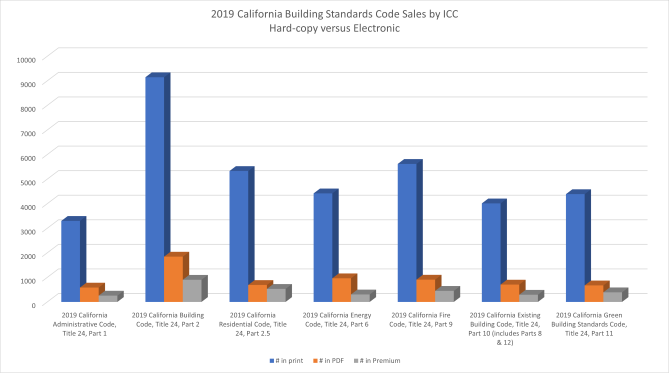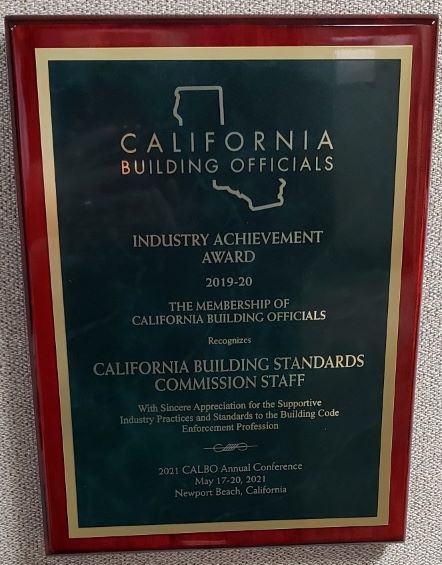CALCode Quarterly - Summer 2021


Executive Director Message
Greetings. I hope this message finds you safe and well. As the state of California begins to reopen and resume normal activities, the California Building Standards Commission (CBSC) continues the work of administering the development of building standards for publication in the California Building Standards Code, Title 24 of the California Code of Regulations (Title 24).
The 2021 Triennial Code Adoption Cycle process to develop the 2022 edition of Title 24 started last year when the various state agencies conducted workshops to develop draft code changes. The formal process started in February with the agencies’ initial submittal of their proposed rulemaking documents. Code Advisory Committee meetings are currently being conducted and public comment periods are already underway. Please visit the 2021 Triennial Rulemaking Cycle webpage for information on all of these activities.
In addition to the code cycle activities, we are looking ahead for ways to better serve our stakeholders and constituents. One initiative is to have most local amendments to building standards (ordinances) available to download from our website. This is a challenge because California law requires that documents posted on state agency websites must meet specific accessibility requirements to ensure access for persons with disabilities. CBSC staff is looking at various solutions for these postings and will issue an Information Bulletin closer to the publication date of the 2022 edition of Title 24.
This edition of CALCode Quarterly features an article that takes an in-depth look at Matrix Adoption Tables. Please also take the time to view the Staff Spotlight that shines this quarter on Associate Construction Analyst Brandon Estes. You will learn about the unique perspective and background he brings to his work with CBSC.
This edition of CALCode Quarterly is presented in a different format than prior versions due to changes in technology. Currently, CBSC is researching alternate platforms to streamline our electronic communications and will continue to issue the CALCode Quarterly to keep you informed.
Despite the challenges experienced over the past year, CBSC remains dedicated to providing excellent service to our partners in building code development—whether they be other state agencies or the many and varied stakeholders in the process. We look forward to building many more accomplishments together with our community. Until then, take care and please contact us if you have questions or need information about Title 24.
Feature Articles

Did you know you can get electronic editions of California’s building codes? The International Code Council (ICC), publisher of most parts of Title 24 (except Parts 3, 4 and 5), offers two different ways to purchase the codes electronically. Since 2000, ICC has sold PDFs of Parts 1, 2, 2.5, 6, 8, 9, 10, 11 and 12, and they started offering Premium cloud-based access in 2013. As of the 2019 edition of Title 24, approximately twenty percent of ICC’s sales are of the electronic versions of the codes. As more users embrace the technology, less paper and other materials for the binders will be used, making for a greener California!

CALCode Quarterly asked Associate Construction Analyst Brandon Estes some questions and here are his answers:
How do you apply your bachelor's and master’s degrees at work?
My Bachelor of Architecture degree has afforded me an understanding of the various components of a building and how such components are pieced together to make a final product. When we stand inside a building, we are surrounded by a complex network of unseen systems that are essential to the operation of a building such as mechanical, structural, plumbing, and electrical systems. This degree has been fundamental to my understanding of these systems and how they work in tandem, and the building code is directly related to the safe and efficient operation of such systems.
I earned my Master of Public Administration (MPA) degree in 2011 in efforts to leave traditional architectural practice and parlay into planning. Planning is similar to architecture in that there are many systems involved, but on a much larger and more complex scale. For example, planning addresses how the built environment relates to transportation systems, natural resources and ecosystems, and jurisdictional authorities. While working on my MPA, I studied subjects such as urban and regional planning, statistics, policy analysis, economics and public management. At CBSC, the background provided by my MPA aids in my understanding of how building standards fit into a much larger public and societal picture, as well as the management of government programs.
Tell us more about your work in Latin America and the Middle East. Any locales where tourists might visit?
While in the private sector, a notable opportunity of mine was the development a new master plan for the Universidad de Monterrey, a Catholic university set in the hills of Monterrey, Mexico. What was particularly challenging was implementing the expansion program within the site constraints, which included new buildings, parking, and sports facilities, while disturbing the topography and local ecosystem as little as possible. Every element of this campus was deliberate and meticulous. It was rewarding to turn data into something functional, and to contribute to generations of future students.
Also, in the private sector, we received a commission by the United Arab Emirates (UAE) to design residential communities in Khalifa City, just outside of Dubai. These were particularly interesting projects because of the vast differences in social and cultural norms between the U.S. and the UAE. For example, in pursuit of privacy and modesty, much attention was given to details such as the relationships of window placement and circulation outside of the buildings to maintain cultural standards and separation between the sexes. The traditional vernacular in the UAE is very formal as well, so incorporating cultural norms, the climate, and the traditional vernacular in these walkable residential communities required much studying on my part.
What do you find most rewarding about your work at CBSC?
What I find most rewarding about working at CBSC is two-fold: I get to apply my education, skills, and experience to the development of California’s Title 24, and that I get to do so while serving the public. Most of my working life has been in the public sector, going as far back as high school and early college when I worked for Napa County. In public service the goal is primarily to improve a good or service, or guarantee a minimum quality of a good or service that benefits the public, and I like being a part of that.
What did you learn while at the Department of Housing and Community Development (HCD) that translates to CBSC, if anything?
Working at HCD changed my perspective of regulatory development. Housing is naturally a political issue, so while at HCD I experienced firsthand how the public, special interests, and governments apply pressure from various angles to shape the building codes. While CBSC is primarily administrative in nature, working at HCD provided me with a view of building standards development from the “other side” so to speak, and an understanding of the intricate, political, and interactive nature of the code development process. This translates to my work at CBSC because I now see rulemaking from both an administrative perspective as well as from a code development perspective.
Rulemaking Participation Poll
Let CBSC know about your participation in Code Adoption Cycles.
QR Code for Poll

CALBO Industry Achievement Award
On May 18, the staff of the California Building Standards Commission (CBSC) was presented with the Industry Achievement Award by the membership of the California Building Officials (CALBO). CBSC’s commissioner Rajesh Patel presented the award at a hybrid in-person and virtual meeting of CALBO. The award is given to organizations that demonstrate a significant contribution to CALBO’s mission of building a stronger and safer California. During the award presentation, Commissioner Patel said, “the words I hear about [CBSC’s] staff are: they’re knowledgeable; they’re dedicated; they’re caring; and they’re kind. And I know as a commissioner, that’s something that you do every day.”

Education and Outreach
March 18 - Associate Construction Analyst Enrique Rodriguez presented CALGreen (Title 24, Part 11) updates at a Green Technology webinar. During this training, he presented information from the current 2019 edition of CALGreen and the supplements published on January 1, 2021 that went into effect on July 1.
April 20 - Executive Director Mia Marvelli virtually attended the County Building Officials Association of California (CBOAC) annual conference and presented information and updates about current CBSC activities.
May 18 - Executive Director Mia Marvelli participated in the state agency panel at the annual meeting of the California Building Officials (CALBO). After the agencies' presentations, CBSC staff were awarded the CALBO Industry Achievement Award by Commissioner Rajesh Patel (see above).
June 4 - Executive Director Mia Marvelli attended the International Code Council (ICC) Tri-chapters Annual Meeting virtually and shared information and updates about current CBSC activities.
June 24 - Associate Construction Analyst Enrique Rodriguez presented CALGreen (Title 24, Part 11) history and updates at a webinar for engineers, architects and designers at HGA, a firm that operates throughout California. This webinar also included segments about the rulemaking process and how the public can participate, and how to use the Matrix Adoption Tables in CALGreen.
ICC Tweets about CBC on Jeopardy
"California's building code says this is a primarily vertical structure containing one or more flues."
Guides and Resources
Here are links to some guides and resources relevant to current CBSC activities:
2019 CALGreen Guide Supplement – Contains rationale, intent, and other details for the code updates made to the 2019 California Green Building Standards Code (Part 11, Title 24, California Code of Regulations, also known as CALGreen) during the Intervening Code Adoption Cycle.
Public Guide to the Building Standards Adoption Process – Contains information regarding how the public can participate in the rulemaking process.
Guide to Filing the Building Permit Fee – Contains regulations updates from the 2019 Intervening Code Adoption Cycle for local jurisdictions.
Maintaining Your Title 24 – How to update and maintain the code binders that contain the California Building Standards Code (Title 24 of the California Code of Regulations).
